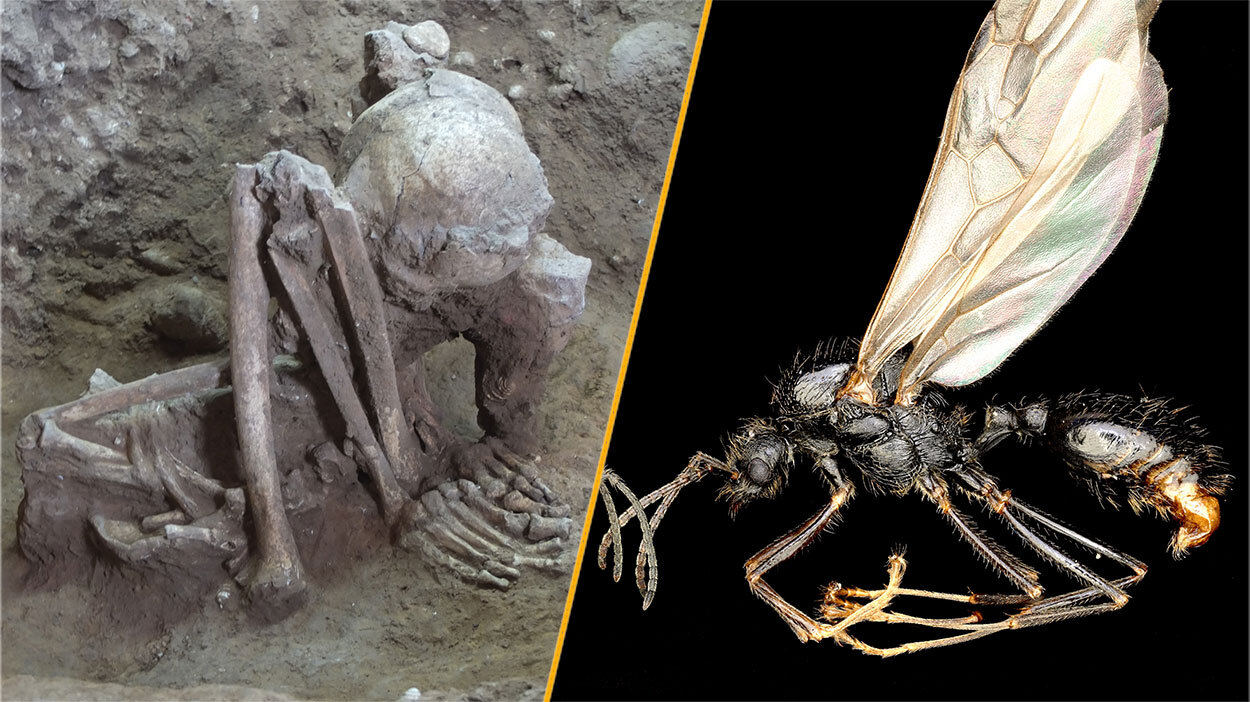Science news this week: The world’s oldest mummy, and an ant that mates with clones of a distant species
By Ben Turner
Copyright livescience

Skip to main content
Close main menu
Live Science
Sign up to our newsletter
View Profile
Search Live Science
Planet Earth
Archaeology
Physics & Math
Human Behavior
Science news
Life’s Little Mysteries
Science quizzes
Newsletters
Story archive
Lab brains could become conscious
Jaguar smashes swim record
Mysterious hand positions on Maya alter
It’s too late to stop AI, readers say
Anthropologist Ella Al-Shamahi on human origins
Don’t miss these
Planet Earth
Science news this week: A 400-year trip to Alpha Centauri and the malevolent AI that may make us consider it
Science news this week: A key Atlantic current nears collapse, the world’s biggest iceberg shatters, and mouse brains rewrite neuroscience
An ‘interstellar visitor’ and the oldest ancient Egyptian genome ever sequenced
Science news this week: NASA finds best evidence of life on Mars and scientists invent visible time crystals
Planet Earth
‘Anti-aging’ magic mushrooms and record-breaking internet speeds
Planet Earth
Science news this week: Black holes galore and blue whales that still sing
A unique new blood type and ‘spiderwebs’ on Mars
Wolves help restore trees in Yellowstone and the largest interstellar object ever seen
Planet Earth
Science news this week: Storms rage on Earth and the sun, and a new moon is spotted around Uranus
Planet Earth
A magnitude 8.8 megaquake and whether we should — and can — stop AI
Planet Earth
‘Bringing back’ giant ancient birds and a shift in Earth’s poles
Science news this week: A world first pig-to-human lung transplant, and SpaceX’s Starship nails a test flight
Human Evolution
DNA has an expiration date. But proteins are revealing secrets about our ancient ancestors we never thought possible.
Arts & Entertainment
Live Science crossword puzzle #9: A ‘royal’ snake that wears a hood — 14 across
Best-ever map of the human genome reveals ‘hidden’ regions of DNA
Archaeology
Science news this week: The world’s oldest mummy, and an ant that mates with clones of a distant species
Ben Turner
20 September 2025
Sept. 20, 2025: Our weekly roundup of the latest science in the news, as well as a few fascinating articles to keep you entertained over the weekend.
When you purchase through links on our site, we may earn an affiliate commission. Here’s how it works.
In this week’s science news, we reported on the world’s oldest mummy, the bizarre cloning behavior of the Iberian harvester ant, the sun’s activity ramping up, and scientists using mysterious fast radio bursts to map the cosmos.
(Image credit: Yousuke Kaifu and Hirofumi Matsumura/ Jonathan Romiguier, Yannick Juvé and Laurent Soldati)
Solar activity rises, defying expectations
Life’s Little Mysteries
World’s oldest mummies discovered
Also in science news this week
Science Spotlight
Something for the weekend
Science in pictures
This week’s science news is stuffed with a menagerie of weird and wonderful animal discoveries. Topping the list are Iberian harvester ants (Messor ibericus), which mate with the male ants of a distantly related species (Messor structor) to procreate.
That’s odd enough on its own, but now scientists have discovered that the harvester ants don’t even need nearby M. structor colonies to achieve this — in a bizarre first, they simply clone the males when they need them.
It’s a “science fiction” feat that has led to the naming of an entirely new reproductive method. With this system, called “xenoparity,” the ants blur the lines between species in a completely unprecedented way.
You may like
Science news this week: A 400-year trip to Alpha Centauri and the malevolent AI that may make us consider it
Science news this week: A key Atlantic current nears collapse, the world’s biggest iceberg shatters, and mouse brains rewrite neuroscience
An ‘interstellar visitor’ and the oldest ancient Egyptian genome ever sequenced
And that’s far from the only fascinating news from the animal world this week. We also learned that the ancestors of ostriches and emus arrived on the six landmasses they call home today via flight.
Meanwhile, a jaguar was recorded smashing the record for the species’ longest documented swim; scientists got insight into how pachycephalosaurs grew their built-for-smashing heads; and an adorable, never-before-seen bearded snailfish was snapped swimming in the depths off California’s coast. The iconically grumpy-looking Pallas’s cat has also been found in a new range, having tripped a camera trap (and posed just in time) for a photo in the eastern Himalayas.
Solar activity rises, defying expectations
‘The sun is slowly waking up’: NASA warns that there may be more extreme space weather for decades to come
Scientists thought the sun was set to quiten down. But it’s doing the exact opposite. (Image credit: NASA Goddard)
If the above stories didn’t rock your world, this one will certainly set off geomagnetic storms in the sky above it: This week, NASA scientists announced that the sun’s activity is set to rise in the coming decades, likely sending more dangerous space weather our way.
That comes as a big surprise, as sunwatchers mostly expected our star to cycle through a period of low activity in the years ahead. But observations of an unusually hyperactive sunspot cycle have upended those predictions. The upshot is that more powerful X-class solar flares and coronal mass ejections will be hurled at Earth. That could prove problematic, given our increasing reliance on satellites and the growing “second space race” to colonize the skies, the moon and even Mars.
Sign up for the Live Science daily newsletter now
Get the world’s most fascinating discoveries delivered straight to your inbox.
Contact me with news and offers from other Future brandsReceive email from us on behalf of our trusted partners or sponsorsBy submitting your information you agree to the Terms & Conditions and Privacy Policy and are aged 16 or over.
Discover more space news
—New report warns that China could overtake the US as top nation in space — and it could happen ‘in 5-10 years,’ expert claims
—There’s a 90% chance we’ll see a black hole explode within a decade, physicists say
You may like
Science news this week: A 400-year trip to Alpha Centauri and the malevolent AI that may make us consider it
Science news this week: A key Atlantic current nears collapse, the world’s biggest iceberg shatters, and mouse brains rewrite neuroscience
An ‘interstellar visitor’ and the oldest ancient Egyptian genome ever sequenced
—Scientists measure the ‘natal kick’ that sent a baby black hole careening through space for the first time
Life’s Little Mysteries
Why do AI chatbots use so much energy?
AIs guzzle untold quantities of energy, but why? (Image credit: Qi Yang via Getty Images)
Chatbots are infamous energy guzzlers, with their rapid rollout and adoption in the past few years leading them to suck up increasingly large shares of electricity from power grids. With their energy consumption expected to skyrocket even higher, we looked into why the greedy bots require so much power and what can be done about it.
—If you enjoyed this, sign up for our Life’s Little Mysteries newsletter
World’s oldest mummies discovered
World’s oldest mummies were smoke-dried 10,000 years ago in China and Southeast Asia, researchers find
The oldest mummies discovered thus far were smoke-dried, a burial practice that likely had spiritual significance. (Image credit: Yousuke Kaifu and Hirofumi Matsumura)
When you think of mummies, your mind will likely travel to Egypt and the roughly 4,500-year-old preserved bodies sealed inside its elaborate tombs. But the discovery of some 10,000-year-old dried human remains deposited in dozens of ancient graves in Southeast Asia and China shows that the world’s oldest known mummies were from a different part of the world.
The remains were smoke-dried over a fire before burial. The ancient practice, which is still performed today, went beyond mere preservation and was likely freighted with spiritual and cultural significance. The scientists who found the mummies also believe they could support a “two-layer model” of migration across Southeast Asia, since the funeral ritual of ancient hunter-gatherers who arrived in the region 65,000 years ago was distinct from the burial rites of Neolithic farmers who arrived 4,000 years ago.
Discover more archaeology news
—1,900-year-old ‘treasure’ found in Roman-era family’s scorched house in Romania
—Anthropologist claims hand positions on 1,300-year-old Maya altar have a deeper meaning
—1,900-year-old oil lamp that provided ‘light in the journey to the afterlife’ found in Roman cemetery in the Netherlands
Also in science news this week
—RFK’s handpicked advisers are coming for the childhood vaccine schedule. Here’s what to know.
—AI could use online images as a backdoor into your computer, alarming new study suggests
—Diagnostic dilemma: A knife broke off in a man’s chest, and he didn’t notice it for 8 years
—Scientists develop ‘full-spectrum’ 6G chip that could transfer data at 100 gigabits per second — 10,000 times faster than 5G
Science Spotlight
‘Like trying to see fog in the dark’: How strange pulses of energy are helping scientists build the ultimate map of the universe
Mysterious flashes of light from deep space could help scientists to map the cosmos. (Image credit: Wei-An Jin)
They arrive as brief flashes in the cosmic dark, powerful jolts of energy that discharge more energy in a few milliseconds than the sun does over an entire year. Yet as much as scientists have puzzled over what processes could be causing these fast radio bursts (FRBs), they still do not fully know what the pulses are.
What is apparent is that FRBs are produced through completely unexpected processes, and far more often than expected. And that makes them very useful to astronomers. In this week’s Science Spotlight, we investigated how scientists are using FRBs to create the ultimate map of our universe.
Something for the weekend
If you’re looking for something a little longer to read over the weekend, here are some of the best interviews, polls and science histories published this week.
— ‘We certainly weren’t exceptional, but now we’re the only ones left’: In new PBS series ‘Human,’ anthropologist Ella Al-Shamahi explores how humans came to dominate Earth [Interview]
—Science history: A tragic gene therapy death that stalled the field for a decade — Sept. 17, 1999 [Science history]
— If tiny lab-grown ‘brains’ became conscious, would it still be OK to experiment on them? [Poll]
Science in pictures
James Webb telescope’s ‘starlit mountaintop’ could be the observatory’s best image yet — Space photo of the week
This photo of a star-forming region in our Milky Way galaxy could be the James Webb Space Telescope’s best. (Image credit: NASA, ESA, CSA, and STScI, A. Pagan (STScI))
The James Webb Space Telescope has gifted us with a deluge of stunning space images since it first came online in 2022, and this week we covered the release of one of its best yet.
Soaring like a rocky mountain against a starry blue sky, the image spotlights Pismis 24, a stellar nursery at the core of the Lobster Nebula. The craggy spires of gas and dust in the foreground span multiple light-years in height, and are being actively sculpted by the radiation of nearby baby stars. It’s a breathtakingly gorgeous scene, and contains two of the brightest stars in our entire Milky Way, measuring 74 and 66 times the size of our sun.
Follow Live Science on social media
Want more science news? Follow our Live Science WhatsApp Channel for the latest discoveries as they happen. It’s the best way to get our expert reporting on the go, but if you don’t use WhatsApp we’re also on Facebook, X (formerly Twitter), Flipboard, Instagram, TikTok, Bluesky and LinkedIn.
Science news this week
Social Links Navigation
Acting Trending News Editor
Ben Turner is a U.K. based writer and editor at Live Science. He covers physics and astronomy, tech and climate change. He graduated from University College London with a degree in particle physics before training as a journalist. When he’s not writing, Ben enjoys reading literature, playing the guitar and embarrassing himself with chess.
You must confirm your public display name before commenting
Please logout and then login again, you will then be prompted to enter your display name.
Science news this week: A 400-year trip to Alpha Centauri and the malevolent AI that may make us consider it
Science news this week: A key Atlantic current nears collapse, the world’s biggest iceberg shatters, and mouse brains rewrite neuroscience
An ‘interstellar visitor’ and the oldest ancient Egyptian genome ever sequenced
Science news this week: NASA finds best evidence of life on Mars and scientists invent visible time crystals
‘Anti-aging’ magic mushrooms and record-breaking internet speeds
Science news this week: Black holes galore and blue whales that still sing
Latest in Archaeology
Ötzi quiz: What do you know about the Iceman mummy who was murdered 5,300 years ago in the Alps?
Anthropologist claims hand positions on 1,300-year-old Maya altar have a deeper meaning
1,900-year-old ‘treasure’ found in Roman-era family’s scorched house in Romania
‘We certainly weren’t exceptional, but now we’re the only ones left’: In new PBS series ‘Human,’ anthropologist Ella Al-Shamahi explores how humans came to dominate Earth
World’s oldest mummies were smoke-dried 10,000 years ago in China and Southeast Asia, researchers find
1,900-year-old oil lamp that provided ‘light in the journey to the afterlife’ found in Roman cemetery in the Netherlands
Latest in News
Who is eligible for this year’s COVID vaccine? Everything you need to know
If tiny lab-grown ‘brains’ became conscious, would it still be OK to experiment on them?
Science news this week: The world’s oldest mummy, and an ant that mates with clones of a distant species
Vast source of rare Earth metal niobium was dragged to the surface when a supercontinent tore apart
Cold snap in Florida made Burmese python puke up a whole deer
Skywatching alert! See 2 bright comets on the same night as a meteor shower this October
LATEST ARTICLES
Who is eligible for this year’s COVID vaccine? Everything you need to know
Ötzi quiz: What do you know about the Iceman mummy who was murdered 5,300 years ago in the Alps?
Why does your breath sometimes stink even after brushing your teeth?
‘Like trying to see fog in the dark’: How strange pulses of energy are helping scientists build the ultimate map of the universe
If tiny lab-grown ‘brains’ became conscious, would it still be OK to experiment on them?
Live Science is part of Future US Inc, an international media group and leading digital publisher. Visit our corporate site.
Contact Future’s experts
Terms and conditions
Privacy policy
Cookies policy
Accessibility Statement
Advertise with us
Web notifications
Editorial standards
How to pitch a story to us
Future US, Inc. Full 7th Floor, 130 West 42nd Street,
Please login or signup to comment
Please wait…



